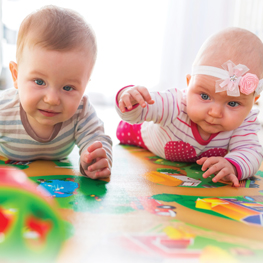
Do you wonder what you can do to help your baby become a strong learner, and ultimately successful in life? When you understand a few things about child development, it’s easy to support and assist their development, with lifelong benefits. Babies are born to learn. The first 18 months of life are crucial in creating the structures we use to learn, to think, to feel, and to express ourselves throughout our lives. These are developed through movement.
When we are born, the various parts of our brain are not all linked up. We develop the ‘wiring’ by moving. We have an inborn program of movement exercises. These are our reflex movements (primitive, postural, etc.). These automatic responses to stimuli each become active in an inherited sequence and baby will practice each movement over and over until they have mastered it, thereby gaining strength and control of their muscles. Baby is then ready for the next ‘exercise.’
You have probably experienced touching a baby’s palm with your finger and those little fingers immediately grasp your finger. The baby did not choose to hold your finger - grasping was an automatic response to the sensation of the pressure of your finger on their palm. That response is teaching their muscles how to grasp and building that movement pattern in their brains, which will be there to support many activities in their lives.
If baby does not master a reflex, it remains active. Do you know people who grip a pencil with too much force, or work their mouths while they write? Another example is difficulty keeping a bicycle or car moving straight forward while turning your head. This is caused by a different reflex in which turning the head to one side causes the limbs on that side to extend and those on the other side to flex.
When reflexes remain active like this in later life, they interfere with our ability to control our actions and use up a lot of energy that then is not available to us.
Retained reflexes and undeveloped movement patterns contribute to many of the learning challenges becoming more prevalent in schools.
As we develop, the reflexes we have integrated form more complex movement patterns. Although these patterns are usually all established in our first 18 months, we need to continue practicing them, refining our skill, into our twenties, as it takes that long for our brains to mature. This is our journey from automatic reactions to autonomy - our own control of our movements and responses. We move from having everything done for us to satisfying our own needs, from dependence to independence.
We have to be able to control our bodies before we can control our behavior.
We also need to develop our vestibular and proprioceptive senses through which we are able to balance and know where our bodies are in space. Rocking, swinging, and spinning are some of the things that help, and children love them.
All this movement of our bodies is actually what grows our brains. It creates the neural networks, the blueprint that enable us to learn, to think, and to solve problems. It develops our ability to express ourselves through language, speech and writing, through dance, music, and the myriad of art-forms humans have created.
What is important is not that our children achieve a developmental stage by a certain age, but that they practice each stage until they master it in their own time. This is what will give them a strong foundation for life and learning.
It is not a race
A building without a strong, stable foundation may collapse. A tree with a deep, extensive root structure is more likely to survive wind and drought.
In our school systems, children are expected to have the physical mechanics of learning already in place when they begin school. For example, the balance and neuromuscular control to sit still needs to be developed by the time a child begins school, as well as the ability to stabilize one body part and move another part freely or precisely, and the eye tracking ability necessary to be able to read.
All of these skills are learned first through the repetitive actions of our reflex movements, then by practicing basic movement patterns, which are more complex developments of the reflex movements. As each one is mastered, it provides the foundation for the next pattern. If a pattern is skipped, or the child is rushed through the pattern or prevented from practicing the movement, there is a ‘gap,’ a weak area in their foundation. They will find ways to compensate - we are incredibly adaptable - but compensations demand extra energy, extra effort, and eventually they may ‘break down.’
The first 18 months of life are the special time we have to create this foundation. Here are some ways to help baby on their journey (note that this is a partial, generalized list):
If any of these development steps has been skipped, there are tools that allow us to help to integrate them at any age, thanks to programs such as Brain Gym®, created by Dr. Paul Dennison; Rhythmic Movement Training, developed by Dr. Harold Blomberg; and Movement Exploration, developed by Carol Ann Erickson.
For more information, contact Dana Luebke, certified Brain Gym®, RMT and ME instructor, at This email address is being protected from spambots. You need JavaScript enabled to view it.. ©2018 by Dana M. Luebke.
Calgary’s Child Magazine © 2024 Calgary’s Child